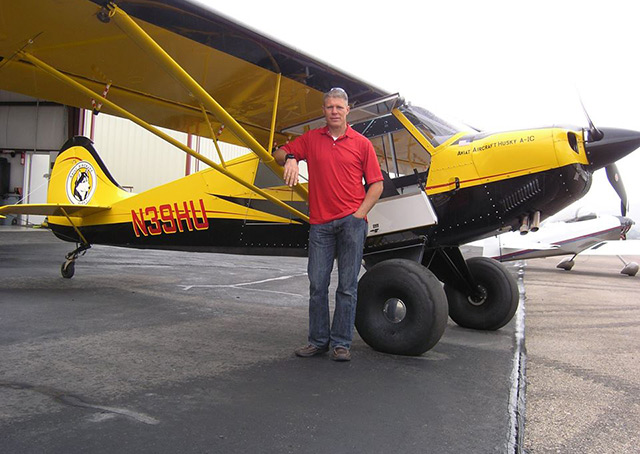1 plane, 1 pilot, 2 saves
Rescue flights a rugged routine for backcountry pilot

Brian Rowser had been airborne for two hours above the rough, high wilderness of northeastern Utah the morning of Sept. 13 when he spotted what he was looking for below: a 77-year-old man who had been missing for three days.
When Rowser, flying an Aviat Husky search aircraft, caught sight of Christian Herrera, the man was standing under a tree in tangled terrain at the base of a 1,000-foot ridge, "waving something white that was attached to a stick."
The waving made Herrera, of Provo, easier to spot, and he appeared to be in pretty good condition. But what may have made the biggest difference to the outcome was a decision Herrera had made after becoming separated from his companions.
"The biggest thing he did that was so smart was he stopped, he did not keep walking," Rowser said, adding that he counsels his own children, "The moment you know you’re lost, stop."
If you keep walking for a day or two, he explained by telephone, you may dramatically expand the area to search, "until you become a needle in a haystack."
Rowser located Herrera in an area called Painters Basin, about four miles from his last known location on King’s Peak—and closer in than Rowser expected to find him based on experience with backcountry searches.
For Rowser, spotting Herrera, enabling a Summit County medical helicopter to fly to the scene and complete the rescue, was the second occasion in two weeks that a flight in the Husky owned by The Refuge Air Ranch at Alpine Airport, Wyoming, brought a missing-person search to a happy conclusion. On Aug. 24, Rowser and a spotter located a 10-year-old Utah County boy who had gone missing the day before in the same high Uinta Mountains, and had spent a bitter cold night exposed to the elements.
The elation volunteers feel when a rescue culminates a search is amplified by the fact that no one takes such outcomes for granted. Among Herrera’s well-wishers was the Garrett Bardsley Foundation, a group "dedicated to using experience and resources to help search and rescue situations for those in need in wilderness terrain." The organization is named for a 12-year-old boy who went missing in the high Uinta Mountains in 2004, and was never found despite searchers flying eight to 10 hours a day, and hundreds more taking part in the ground effort.
Rowser’s work on this summer’s rescues was lauded by the Wasatch County Sheriff’s Office, which has on several occasions availed itself of the owner-donated use of the Husky, with Rowser volunteering as the pilot, and fuel contributed by OK3 Air, the fixed-base operator in Heber City, Utah, Rowser’s base when flying searches in the area. The Uinta-Wasatch-Cache National Forest region is a popular backcountry destination, especially for visitors from metro Salt Lake City, he said.
Rowser had been a sheriff’s department employee for 10 years, giving flying lesson on the side before becoming a full-time pilot whose work now includes flying a Cessna Citation CJ3 jet, helicopters, and gliders.
The move marked a return to the aviation business that he had grown up with, in a family that ran Heber City’s FBO from when he was 10 until he was about 20 years old. Like many who grow up in aviation, Rowser soloed on his sixteenth birthday, earned his private pilot certificate at 17, still mentors many pilots, and expects that a third generation of his family will soon earn a pilot certificate in gliders.
It’s not unusual for other pilots to share with Rowser their interest in flying backcountry search-and-rescue missions. He offers a reality check, including the hazards of navigating high, rough terrain, rapidly rising ridges, and canyons under high density altitude conditions in which "performance is really suffering."
"It’s extremely technical flying," he said. "You’re low, you’re slow. You can’t fly fast and search. You’re low to the ground, but it is also low-energy flying, typically 60 miles per hour. It’s dangerous if you’re not paying attention to where the downdrafts are, where the lift is."
Flying rescue missions means poking into box canyons that you’d usually want no part of, "but now you have to spend about 30 minutes up in there."
Rowser learned that the way to do it safely was to come down "like a skateboarder in a half pipe." Flying back and forth across the canyon, with the Husky configured with partial flaps, gives him a way out by assuring that a 90-degree turn down the canyon is available. "The Husky can turn sharply," he said.
An additional complication of scouring the chaotic backcountry for a missing person is that after a few days, it’s hard to know whether to look for someone who is “still vertical,” or not.
If there is a typical scenario that may lead to a search, it is when someone in a group winds up apart, either inadvertently or intentionally, from the rest. "Getting separated from their group is kind of a big one," Rowser said. For example, a man hunting with his children decides to return alone to their camp. "But they miss the camp, and now it is a 360-degree question" about where they went next. "And cell phones don’t work out there." The hypothetical hunter’s wandering enlarges the area to search. That’s why it was fortunate that Herrera, who according to news reports had dismounted from a horse to take photographs when he became separated from his group, stayed put and awaited rescue, said Rowser.



